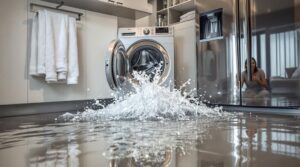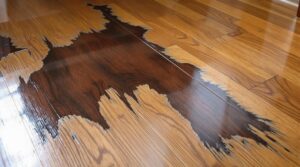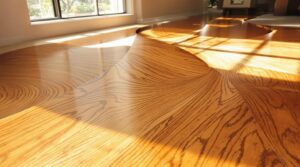Fixing hardwood floor water damage requires immediate action through systematic steps. Initial response involves stopping water sources and extracting moisture using wet/dry vacuums and absorbent materials. Professional assessment with moisture meters determines damage extent and necessary restoration methods. Thorough drying utilizing dehumidifiers and strategic air movement precedes board repair or replacement. Proper sanitization prevents mold growth. Understanding the entire restoration process guarantees ideal outcomes and potential insurance claim success.
Key Takeaways
- Stop active water sources immediately and extract standing water using wet/dry vacuums and water-absorbent mats.
- Position dehumidifiers and fans strategically to maintain indoor humidity between 30-50% during the drying process.
- Remove damaged floorboards systematically with pry tools and replace them with matching materials based on grain pattern.
- Clean and sanitize affected areas using non-abrasive cleaners and appropriate disinfectants to prevent mold growth.
- Monitor moisture levels continuously with moisture meters throughout restoration to ensure complete drying before repairs.
Quick Assessment of Water Damage Types
Four primary types of water damage can affect hardwood floors: discoloration, warping, buckling, and mold growth. Each type presents distinct damage indicators that require specific remediation approaches.
Discoloration manifests as dark patches or stains on the wood surface, indicating moisture penetration.
Warping occurs when boards swell unevenly, creating a wavy appearance across the floor.
Buckling, a severe condition, results in complete separation of boards from the subfloor.
Mold growth, accompanied by musty odors, suggests sustained moisture exposure requiring immediate attention. High indoor humidity can accelerate the development of wood floor deterioration.
Professional assessment involves moisture measurement using specialized meters to determine damage depth.
Visual inspection reveals rising panels, cracked wood, and crowning.
These indicators help determine whether boards require spot treatment, refinishing, or complete replacement to restore floor integrity.
Initial Water Source Control and Cleanup Steps
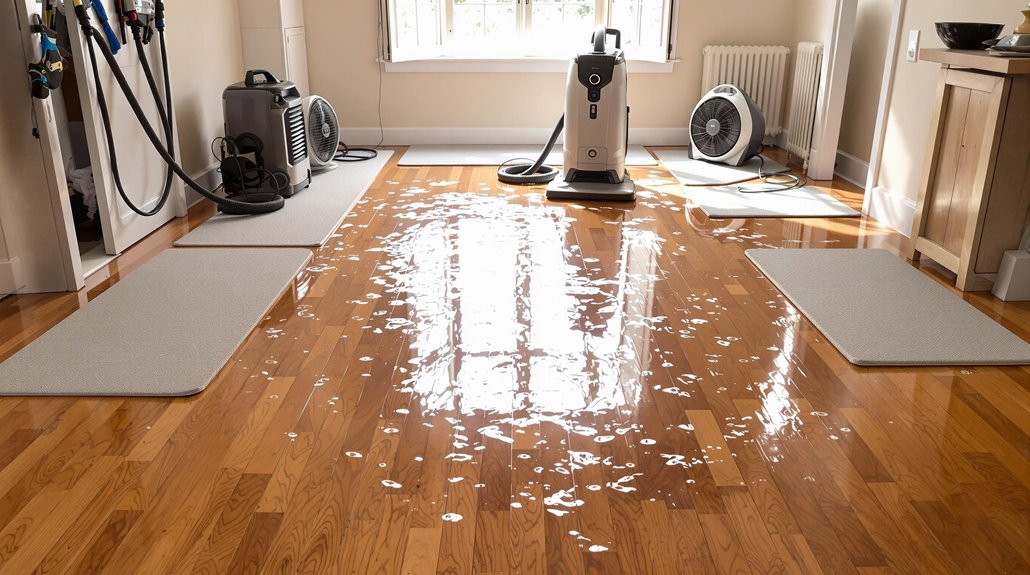
Swift intervention during water damage incidents requires a systematic approach to source control and immediate cleanup procedures.
The first critical steps involve identifying and stopping active water sources by repairing leaks, shutting off main water supplies, and preventing further ingress of moisture. Using water-absorbent mats near affected areas helps contain spreading moisture during the cleanup process.
Implementation of effective cleanup techniques follows immediately after source control. This process includes utilizing wet/dry vacuums for water extraction, deploying dehumidifiers, and establishing proper ventilation through strategic fan placement.
Safety protocols mandate disconnecting electrical systems and documenting damage for insurance purposes before proceeding with cleanup operations.
Maintaining ideal indoor humidity levels between 30-50% and employing protective gear during remediation work are essential components of the process.
Regular monitoring with hygrometers helps guarantee conditions remain conducive to preventing further water damage during the restoration phase.
Essential Drying and Sanitizing Methods
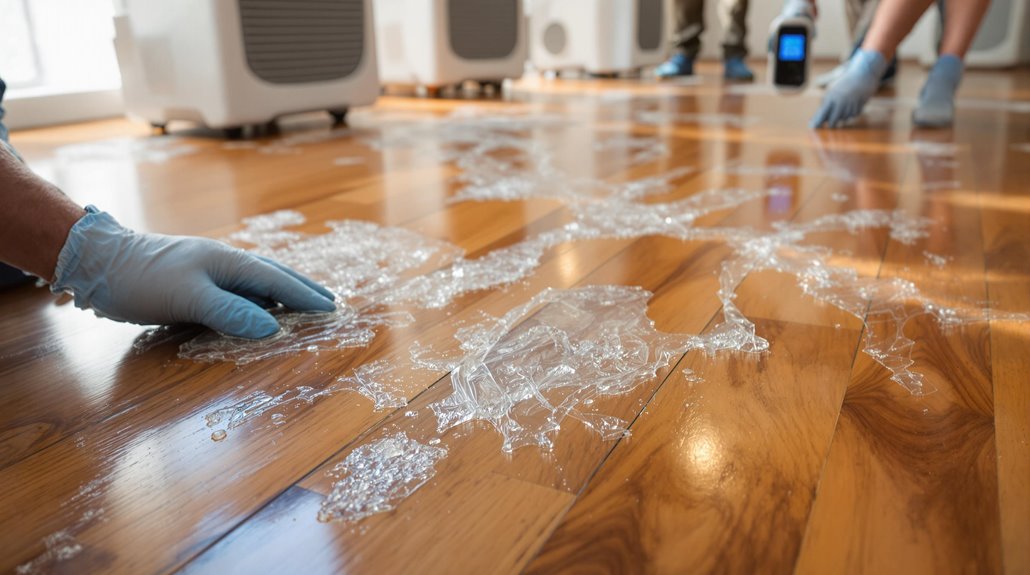
Implementing effective drying and sanitizing methods requires a thorough approach that combines technical expertise with specialized equipment. Professional drying techniques involve strategic positioning of dehumidifiers, air movers, and monitoring equipment to achieve peak moisture reduction. Multiple drying methods may need to be combined for severe water damage cases. Sanitizing methods must be executed systematically to prevent mold growth and preserve floor integrity.
| Equipment | Function | Application |
|---|---|---|
| Panel System | Moisture Extraction | 3-6" panel spacing |
| Desiccant Dehumidifier | Humidity Control | External ducting |
| Moisture Meters | Progress Monitoring | Regular readings |
Advanced drying systems, including heat drying and desiccant dehumidification, must be implemented within containment areas to maintain controlled environments. Proper sanitization follows with non-abrasive cleaning methods and appropriate disinfectants, while continuous moisture monitoring guarantees successful restoration of the hardwood flooring.
Repairing and Replacing Damaged Floorboards
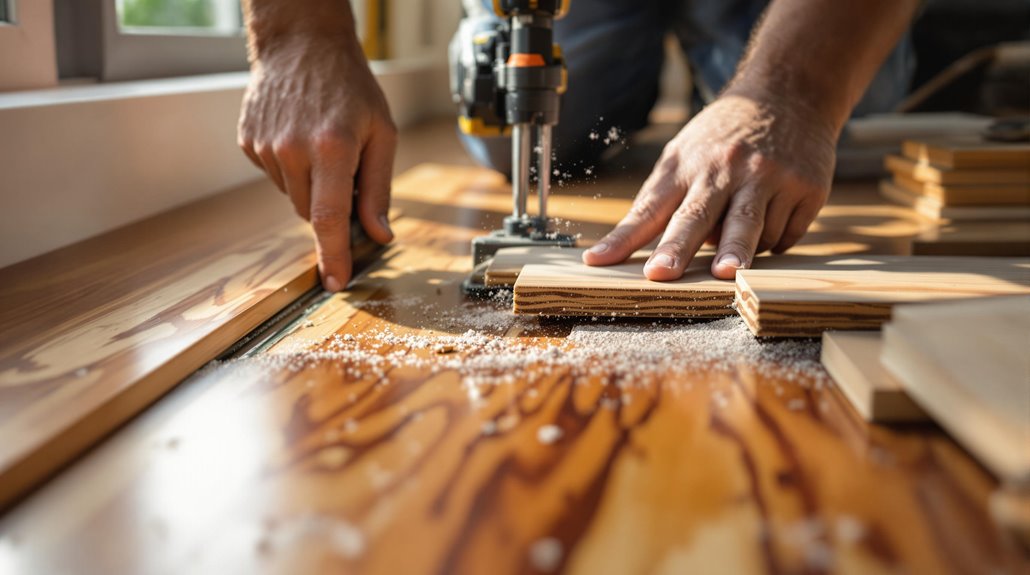
The complexity of repairing water-damaged hardwood floors extends beyond drying and sanitizing to include precise board replacement procedures. The process requires careful assessment of damaged floorboard materials and implementation of proper installation techniques to guarantee structural integrity and aesthetic continuity.
- Systematic removal of damaged boards using specialized pry tools
- Selection of matching replacement materials considering grain pattern and wood species
- Professional installation employing proper fastening methods
- Thorough finishing process including sanding and sealing
Successful repair involves meticulous attention to detail during both removal and replacement phases. Technicians must carefully extract damaged sections without affecting surrounding boards, then install new materials using industry-standard techniques.
The final steps of sanding and finishing guarantee seamless integration with the existing floor, making the repair virtually undetectable once complete.
Prevention Strategies and Professional Help
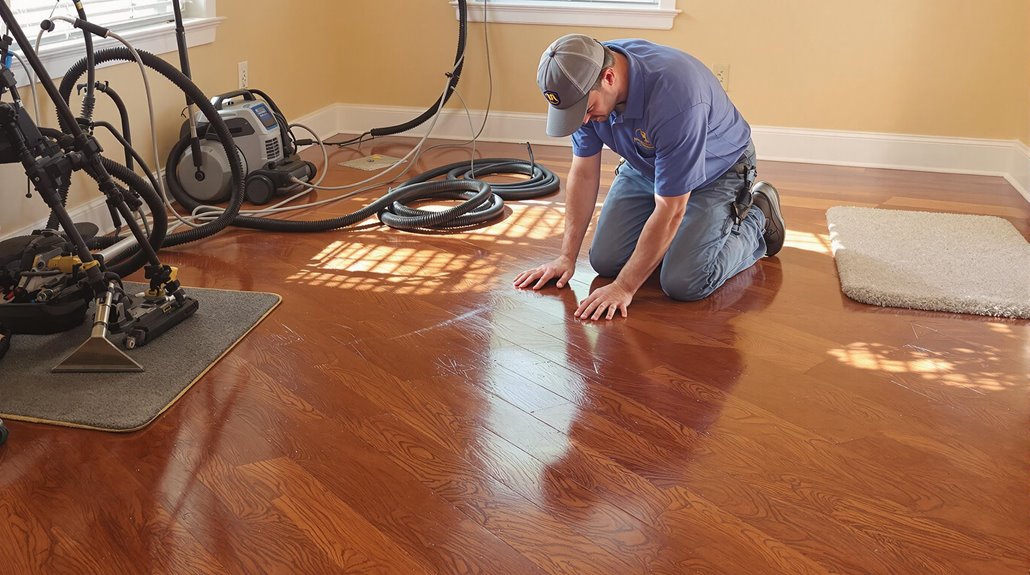
Effective prevention and timely professional intervention serve as cornerstones in protecting hardwood floors from water damage.
Implementing thorough preventive maintenance includes regular inspections for leaks, monitoring humidity levels, and maintaining protective finishes through proper sealing and coating applications. Strategic placement of mats in high-risk areas and immediate response to spills further safeguard the flooring.
When water damage occurs, professional services become essential for extensive restoration. Qualified restoration specialists possess specialized equipment and expertise to address complex repairs effectively.
These professionals evaluate damage extent, implement appropriate drying techniques, and execute necessary repairs. Selection criteria for contractors should include verified experience in hardwood floor restoration, proper certification, and documented success in similar projects.
Regular maintenance combined with expert intervention guarantees ideal floor protection and longevity.
The Benefits Of Consulting A Public Adjuster
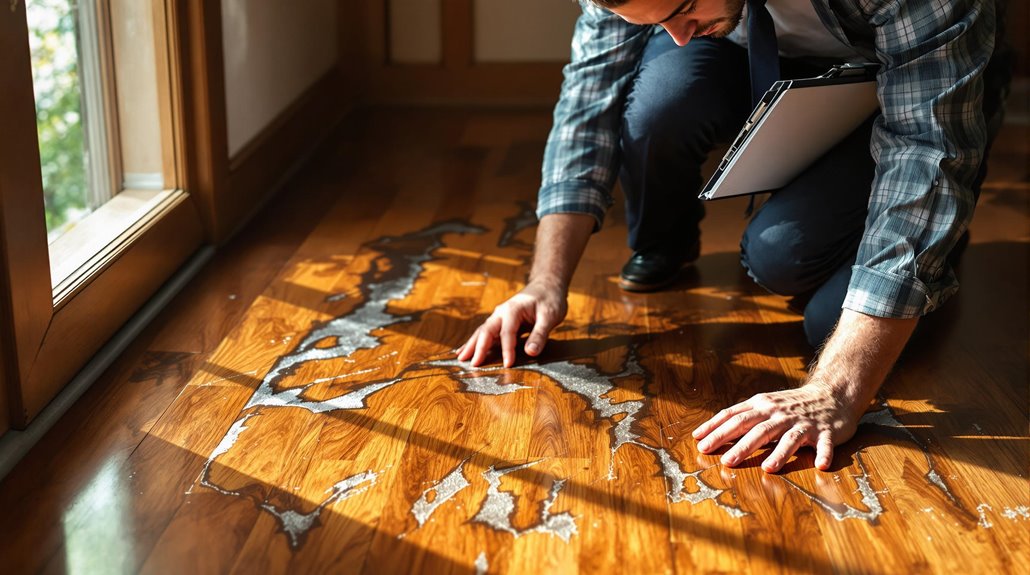
Public adjusters offer specialized expertise in managing hardwood floor water damage claims, providing objective assessments that accurately document both visible and concealed damage.
Their professional representation streamlines the insurance claims process through efficient documentation, policy interpretation, and direct communication with insurance carriers.
Studies indicate that claims handled by public adjusters typically result in considerably higher settlements compared to those filed independently, ensuring property owners receive adequate compensation for proper hardwood floor restoration.
Early involvement of licensed public adjusters helps prevent complications and delays while ensuring thorough documentation of all water-related damages.
Expertise In Insurance Claims
When dealing with extensive hardwood floor water damage, consulting a qualified public adjuster can greatly improve the insurance claims process and settlement outcomes. Public adjusters provide expert insurance policy analysis and implement proven claim negotiation strategies to maximize settlements for policyholders.
- Conducts thorough policy reviews to identify coverage limits, exclusions, and entitlements.
- Prepares detailed documentation including damage assessments, repair estimates, and supporting evidence.
- Manages all communication with insurance carriers while advocating for policyholder interests.
- Evaluates settlement offers and negotiates for fair compensation based on policy terms.
These professionals work on a contingency basis, typically charging up to 10% of the claim settlement in Texas, with no upfront fees required.
Their expertise helps guarantee proper claim preparation and best settlement outcomes for water-damaged hardwood floors.
For particularly complex claims involving multiple parties or disputed coverage, public adjusters often work alongside legal professionals to provide comprehensive claim support and protection of policyholder rights.
Objective Damage Assessment
Professional damage assessment conducted by licensed public adjusters provides property owners with detailed documentation and analysis of hardwood floor water damage claims. These experts meticulously evaluate the extent of the damage, ensuring that property owners receive fair compensation from their insurance companies. In addition to their assessment, licensed public adjusters often provide valuable insights, including essential water damage prevention tips, to help homeowners mitigate future risks. By leveraging their expertise, property owners can not only navigate the claims process more effectively but also enhance the longevity of their hardwood floors.
Using advanced diagnostic tools like moisture meters and thermal imaging equipment, these experts identify hidden damages that may not be visible to the untrained eye, including structural weaknesses and potential mold growth beneath the flooring surface.
Their extensive evaluation delivers essential restoration insights regarding repair timelines, cost projections, and necessary remediation steps.
Public adjusters meticulously document all damage aspects, from surface deterioration to subsurface complications, ensuring that insurance claims accurately reflect the full scope of repairs needed.
This systematic approach helps property owners secure fair compensation while establishing a clear framework for the restoration process, supported by detailed evidence and professional documentation.
With higher settlement rates reported when using public adjusters versus handling claims independently, property owners often benefit from their expertise in navigating complex insurance processes.
Streamlined Claim Process
Engaging a licensed public adjuster greatly expedites the insurance claims process for hardwood floor water damage. These professionals manage extensive claim documentation while implementing effective negotiation strategies with insurance carriers. Their expertise guarantees maximum claim settlements while minimizing policyholder stress during the recovery process.
- Documentation of all water-damaged hardwood flooring areas with detailed photographic evidence
- Professional assessment of repair costs and replacement requirements
- Strategic presentation of claim materials to insurance carriers
- Continuous monitoring of claim status and settlement negotiations
Public adjusters operate on a contingency fee basis, eliminating upfront costs for property owners. Their professional representation guarantees compliance with policy terms while maintaining transparent communication throughout the claims process.
This systematic approach helps property owners receive fair compensation for their water-damaged hardwood floors while adhering to all regulatory requirements.
Total loss scenarios typically warrant the assistance of a public adjuster to ensure proper valuation and full compensation for extensive water damage repairs.
Higher Claim Payouts & Settlements
By working with public adjusters, property owners typically secure significantly higher claim settlements for hardwood floor water damage compared to filing independently.
Public adjusters employ advanced assessment tools, including moisture meters and thermal imaging, to document the full scope of damage, uncovering hidden issues that might otherwise go unnoticed.
Their expertise in claim negotiation and settlement strategies, combined with an extensive understanding of insurance policies, enables them to identify all covered losses and maximize compensation.
Working on a contingency basis, these professionals advocate for ideal payouts while documenting both visible and concealed damages.
Their thorough approach to damage evaluation, coupled with skilled negotiation tactics, helps counteract common insurance company strategies that might minimize settlement amounts, ensuring property owners receive fair compensation for their hardwood floor restoration needs.
With a national average of $61,465 annual salary, insurance adjusters have the professional experience and financial motivation to thoroughly investigate and validate claims for maximum benefit.
About The Public Claims Adjusters Network (PCAN)
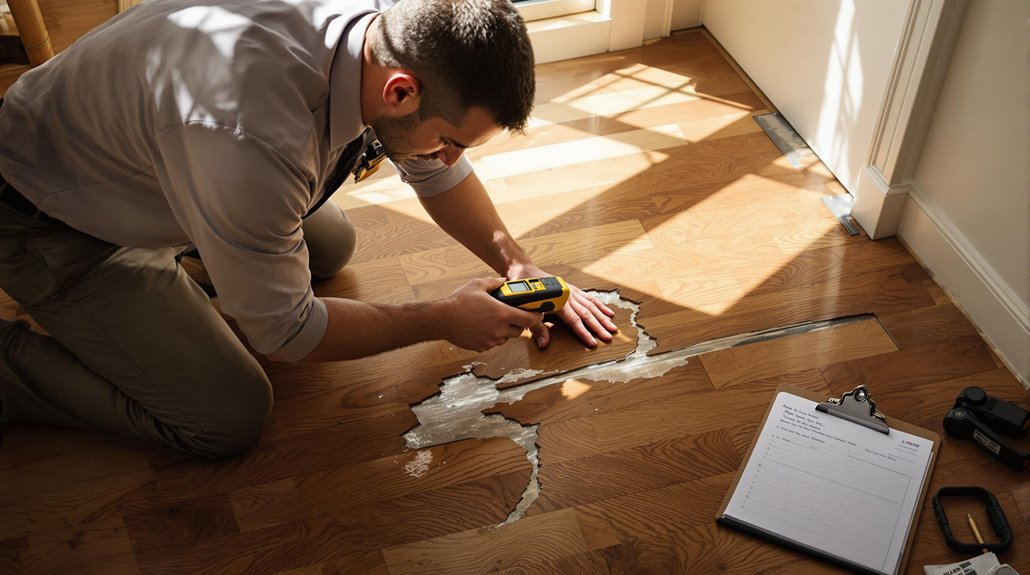
The Public Claims Adjusters Network (PCAN) represents a nationwide coalition of licensed insurance claims professionals who specialize in advocating for policyholders during property damage claims.
Operating independently from insurance companies, PCAN's adjusters leverage their expertise to maximize claim settlements while managing all aspects of the claims process.
Key aspects of PCAN's operations include:
- Extensive claims advocacy spanning all 50 states and five continents
- Specialized damage assessment protocols for both residential and commercial properties
- Strategic policy interpretation and documentation preparation services
- Direct management of communications with insurers, contractors, and stakeholders
PCAN's adjusters maintain strict licensing requirements and undergo continuous training to stay current with industry standards.
Their client-focused approach guarantees thorough representation throughout the claims lifecycle, from initial filing through final settlement negotiations.
Frequently Asked Questions
How Much Does Insurance Typically Cover for Hardwood Floor Water Damage?
Every drop counts: Insurance claims for water damage typically cover 100% of hardwood floor replacement costs under replacement value coverage, while actual cash value policies factor in depreciation before payout.
Can Engineered Hardwood Floors Be Saved After Flooding?
Engineered hardwood floors can potentially be salvaged after flooding through professional flooring assessment and prompt flood repair, depending on damage severity, water exposure duration, and successful drying implementation.
How Long Should I Wait Before Refinishing Water-Damaged Hardwood Floors?
Time is money when dealing with water-damaged floors. Professional refinishing techniques require complete drying, typically 7-10 days minimum, with monitoring moisture levels below 12% before beginning restoration work.
Will Homeowners Insurance Cover Slow Water Leaks That Damaged My Floors?
Standard homeowners insurance typically excludes gradual water leaks. Insurance claims require prompt leak detection and documentation. Long-term seepage damage falls under maintenance issues, making coverage unlikely without specific endorsements.
What's the Average Time for Hardwood Floors to Completely Dry After Water Damage?
Professional drying processes typically require 7-10 days, while natural drying extends 3-6 months. Moisture levels must reach 4% or below, varying with environmental conditions and wood type.
References
- https://www.alldryus.com/blog/water/water-damaged-wood-floors/
- https://www.1800waterdamage.com/wood-floor-water-damage/
- https://romerohardwoodfloor.com/how-to-repair-a-water-damaged-hardwood-floor/
- https://www.puroclean.com/blog/what-should-i-consider-after-a-wood-floor-is-flooded/
- https://www.wagnermeters.com/moisture-meters/wood-info/warning-signs-floor-moisture-problems/
- https://www.steamyconcepts.com/blog/2023/09/01/water-damage-on-wood-floors-types-of-damage-restoration/
- https://advanceddri.com/blog/how-to-detect-and-repair-hardwood-floor-water-damage/
- https://puredry.com/wood-floor-water-damage/
- https://jenkinsrestorations.com/how-to-minimize-and-repair-water-damage-to-wood-floors/
- https://floorsanding.co.uk/how-to-protect-wood-floors-from-water-damage/


